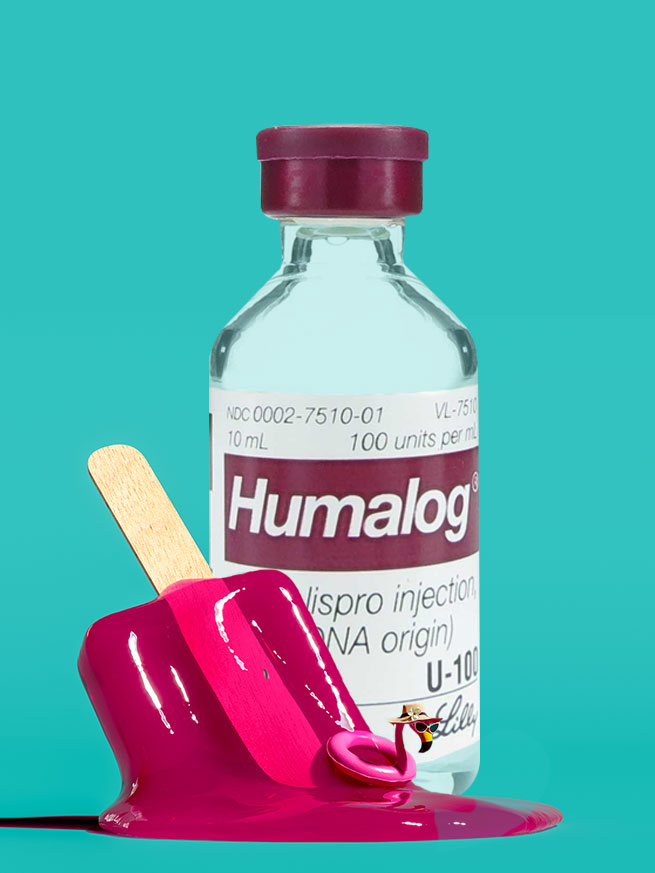Mounting evidence is showing that insulin CAN withstand high temperatures. It doesn’t need to be as cold as we’ve been told.
Gone are the days of wondering: Shoot! I left my insulin in the hot car or the sun… Is my insulin still good? Should I throw it away? Will my insulin work if it got warm?
The Old Song and Dance
In my early days of diabetes not only did I refrigerate my unopened insulin BUT ALSO my OPENED insulin.
That’s right, my opened insulin was either in the fridge or in a supply case with an ice pack… at all times
That’s because I was told to do so. Insulin had to be cold. If it wasn’t cold it would spoil.
I remember going to the beach with my insulin in a Frio bag AND putting that bag in a cooler with ice.
I also remember that anytime I stayed at a hotel I would tell the front desk that my room needed a mini fridge, for medical reasons, for my insulin. And actually, a couple of times when I would reserve a room online, there was a box I could check under “Medical Aid” to request a mini fridge in my room.
Over the years I became more lax with this rule, but it was still a guiding principle in my mind that insulin had to be cold (or at the very least around 68-71°F for no loner than 1 month)
HOWEVER more and more evidence has been coming out recently that suggested that insulin can withstand high temperatures.
The Study That Broke the Internet
In March 2023, a new pilot study was published in the Lancet.
Pilot meaning small-scale, preliminary research before the main or full study.
This study aimed to investigate the stability of insulin stored in non-refrigerated conditions for longer than 1 month (the current recommendation).
They wanted to study the potency between insulin stored at cooler temperatures vs warmer temperatures over the course of four months.
This small study took place during the summer in India, and looked at six test participants.
The participants had their insulin stored at room temperature (which, reminder, was during the SUMMER IN INDIA ️☀️).
Their insulin was stored on high shelves, in cupboards, or in clay pots. The temperature was measured every 15 min by electronic data loggers. The mean maximum temperatures that the insulin sitting in ranged from about 84 – 95°F.
Control samples of the insulin were refrigerated at the research center for comparison.
The Results
The results showed that the insulin that was stored without refrigeration maintained 95% or more of its potency after four months.
You read that right.
When insulin was stored for four months in 84 – 95°F heat it maintained 95% or more of its potency!
SooOOoo What Does this Mean for Insulin Guidelines?
Further research with larger sample sizes and in vivo testing (meaning not just looking at its potency via a lab, but actually injecting it into a person) will need to be done to confirm the findings that insulin can withstand high temperatures
If confirmed, these results could mean that regulatory agencies (like the FDA) and insulin manufacturers would need to change their current recommendation of disposing unrefrigerated insulin after 1 month at room temperature, which they consider to be between 68-77°F.
It also puts pressure on the insulin manufacturers to test insulin potency and safety under non-standard storage conditions… aka real world settings.
What Does this Mean for People with Diabetes?
Updating the usage period of unrefrigerated insulin would save people tons of money. It would reduce waste and improve insulin access in regions with limited resources.
It also helps to relieve anxiety & cost for people who have intermittent pharmacy supplies, have to deal with travel costs, or have issues with getting to a clinic or pharmacy regularly.
Also, The Dagahaley Refugee Camp Study
In 2021 PLOS ONE published a study that was facilitated by the nonprofit Doctors Without Borders.
The study was conducted in Kenya’s Dagahaley Refugee Camp.
The study measured insulin withstanding their daily temperature fluctuations of 77-99°F for four weeks.
Since refrigerators are hard to come by in the refugee camp, and with the current guidelines requiring insulin to be stored between 68-77°F, people with T1D need to travel to a treatment clinic multiple times per day to get their insulin injections.
I cannot even imagine how difficult that has to be.
The Results
The insulin that had been stored in the real-world temperatures of Kenya (77-99°F) when compared to the control batch that was kept in the refrigerator, had NO DIFFERENCE.
The insulin’s potency and structure were found to be identical.
IDENTICAL.
But Wait… It Gets Better!
The researchers extended the experiment from four weeks to 12 weeks and the results remained the same.
Insulin that was exposed to nearly 100°F EVERY DAY for 12 weeks (about 3 months) remained just as potent as the insulin that was in a temperature-controlled refrigerator.
Then The Researchers Put the Insulin in the Oven (seriously)
Since 100°F temperatures didn’t ruin insulin, the researchers want to find out what temp does?
The researchers turned on an oven to 175°F and put the insulin inside for 30 minutes.
They probably thought: this will certainly ruin it.
You might be thinking that too… I know I did.
But it really didn’t.
It did lose potency, but not by much. They noticed that heating insulin to 175°F for 30 minutes decreased the insulin’s potency by 9-14%.
Since this was not enough to sufficiently denature the insulin they turned the oven on again.
They turned the oven to 239°F. And that did the trick of denaturing the insulin.
More Studies Showing That Insulin Can Withstand High Temperatures
- A 2009 study found that insulin stored at a constant 77°F had a shelf life of 199 days (that’s about 6.5 months)
- A study from 1972 found that insulin retained sufficient potency for 10 years at 59°F, 20 months at 77°F, three months at 95°F, or 10 days at 113°F.
The Takeaways
Insulin has (and continues) to outperform the manufacturers specifications for both shelf life and heat resilience. Insulin can withstand high temperatures, much higher than the manufacturer has stated.
Given the cost of insulin and global concerns with insulin access, countless lives would be saved if we had more accurate guidelines, from the insulin manufacturers, on insulin storage and handling.
If your insulin isn’t working as well as it should be, it could be an issue with your injection site, and not the insulin itself. Read more…






Well we do not want it to underperform specifications. I think that the findings are fine, can it be used? sure. Do I want to use it? Well in a pinch, sure. But routinely? No I will pass. We know ti degrades at some rate, but until we know or can test at home, I will stick to less than 70 degrees. One other side of this is cold. We know absolutely that frozen insulin is wasted insulin.
At-home-test would be amazing!
Sayyyy whhat now?! I cannot tell you how much EXPENSIVE insulin i’ve tossed because it was left outside on a summer day. SMH. Thank you for sharing these studies.
[…] But, even if it were to warm up significantly from our body heat, Insulin is proving to be more heat resilient that we once thought. […]